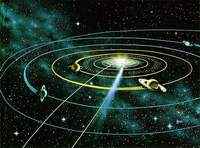Life on other planets most likely based on absolutely different laws and principles
Time and again scientists find life forms in the coldest, hottest and most unsuitable spots on Earth. The search for life continues on Mars, Titan and other planets lying beyond.

By comparison to other planets of the solar system, Titan, the largest moon of Saturn, has arguably the most striking landscapes. There are numerous deserts stretching for hundreds of kilometers. The wind-blown dunes lining the deserts are 100 meters high. The images recorded over the last two years by NASA’s spacecraft Cassini show a number of river beds, which were cut by the flowing of liquid methane in the past. The European Huygens probe, which was tucked under Cassini’s wing, landed on Titan in 2005. The soil samples taken from the landing site showed some similarities between the samples and common wet sand in terms of consistence. Titan’s atmosphere proved to be ten times as dense as that of the Earth; it is believed to be composed mostly of complex organic molecules.
“When it comes to astrobiology, Titan is the most interesting planet of the solar system,” says Peter Ward, a senior researcher at the University of Washington. He leads a research team involved in a NASA-sponsored study. “The makeup of matter obtained from Titan looks pretty weird. We haven’t come across anything similar to that before. I believe life forms on Titan may resemble real aliens should we find any life forms out there,” adds Ward.
The opportunities for scientists to take a closer look at distant planets have been greatly increased by Cassini and its sister craft over the last few years. The search for life forms within the solar system intensified dramatically. However, some scientists believe that most fundamental and important conclusions can be made on the basis of results obtained by research conducted on Earth. On this planet life forms were discovered in places that seem to be completely unsuitable for the purpose. Life was found in a variety of spots ranging from the South Pole to geysers.
Will it be easier for scientists to look into the origins of life on other planets by using knowledge of factors which make life on Earth flourish? What are the forms that life can take? The answer to the question leads to another question concerning the existence of the living organisms within and outside the solar system.
How did life begin on Earth?
On July 3, 2005, the Deep Impact spacecraft released a 400-kilogram probe so that it might intercept course with comet Tempel 1, which was traveling at a speed of 37,000 km/h at the time. A collision ensued, and the probe dented a crater on the comet’s surface. A cloud of debris and dust got sprayed across nearby space. That carefully staged event was recorded by cameras on board Deep Impact. Scientists keep analyzing the images of a man-made space disaster. The results of the study may hold a clue to the mystery of the origins of life on Earth. It will be easier to understand the way life originated on Earth if scientists manage to find out how the microbes grabbed hold of the earth’s surface. All life forms on the planet are made of the same bricks. The proteins are composed of substances known as amino acids. All genes are formed by molecules (nucleotides) attached to the backbone of phosphates and sugar (ribose).
How and when the above substances made it to Earth is one of the biggest mysteries. By all estimates, life on Earth may have originated from 4.55 billion to 3.45 billion years ago. The former refers to the time the planet formed, and the latter concerns the earliest (and universally indisputable) stage in the development of fossil microbes on the planet.
Not unlike the case of collision of the space probe and comet Temple 1, some life components may have been inserted to Earth within the above period. Scientists have already learned that the cloud of matter sprayed into space after the collision was rich in organic matter. The findings could help scientists arrive at a conclusion that the comet itself contains significant amounts of those vitally important substances.
The remaining part of the mystery hasto do with thewaythe abovebrickswere used for building rather complex structures of the most primitive living organisms. Some scientists argue that water rich in organic matter was consistently moved into the marshy tidal areas by the ocean waves, and the hot sun and relentless surf acted as natural catalysts in that biochemical reactor. Others believe that life started in the depths of silt deposits running along the ridges at the sea bed. High-energy mineral compounds were oozing from the cracks in the earth’s crust.
“The mystery reminds me of a huge jigsaw puzzle. All the pieces were scattered around the table. So far we’ve put some of them together again,” says Bruce Runneger, scientific director at NASA Astrobiology Institute. “We can see parts of the sky and some other things come into view around the edges but the picture is yet to be completed,” adds Runneger.
The picture seems to point out the direction of further search efforts to be conducted outside the solar system as more parts of the jigsaw are being fitted together. Byall appearances, Mars had a warm and humid atmosphere some four billion years ago. Therefore, life may have started on the Red Planet. But life might as well have started in some other less favorable conditions e.g. on Titan provided that a combination of certain factors and components is all it takes for the beginning of life. By adding more to their knowledge of the role of planets, scientists will be probably capable of locating planets of other solar systems on which life may theoretically exist.
Astronomers will be looking for planetary systems surrounded with heavy clouds of comets if the latter should be exposed as a means of transport for delivering key chemical elements to planets.
Is water a must for the beginning of life?
We are well aware of the fact that some kind of liquid is required for the beginning of life. Molecules move extremely fast in a gaseous environment, they cannot take part in relatively complex chemical relations that are essential for the existence of life. On the contrary, no molecular movement whatsoever is possible in solid objects. Liquid is a solvent that is always required to keep life processes going. The solvent enables molecules to perform a wide variety of movements and contact one another.
Earth is a pretty wet place. Most of it is covered with oceans, seas, lakes and rivers. The earth’s atmosphere is rife with clouds and steam. Water soaking the earth’s crust runs deep to many kilometers, and continental plateaus are afloat in water solvent. Whether life forms occur in the desert or inside a large mass of stone, water acts as a liquid solvent in every life process on Earth. Does it mean that water is the only lifeblood? Or maybe it just came in handy for the planet of Earth?
The above question is one of the most debatable issues in astrobiology. Theoretically, a liquid natural gas or some hydrocarbon may serve a universal vehicle for some exotic life form based on the atoms of carbon. Life may develop in liquids of another type if silicon, not carbon, should be the cornerstone of life.
These days the search for life is focused on places where water used to exit or still is in a liquid form. However, some space biologists believe that the narrowing of a field of vision without good reason would be unwise. “Are you sure that the strategy built around the imperative ‘Look for water!’ won’t put blinders on our eyes as we peer at more exotic forms of life, the ones that don’t need any water at all?” says Steven Benner at the Foundation of Applied Studies in Molecular Evolution. Mars is the only planet that shows indisputable evidence of the existence of water. Europa, a large natural satellite of the planet Jupiter, also has water. Enceladus, Saturn’s satellite, is probably has some water reserves too. However, celestial bodies may have other liquids capable of keeping life forms going. There are clouds of liquid ammonia hanging over Jupiter. Venus is wrapped up in a veil of sulfurous acid. The images of Titan show something resembling lakes of liquid methane.
Izvestia Nauki
Translated by Guerman Grachev
Pravda.ru
Subscribe to Pravda.Ru Telegram channel, Facebook, RSS!


